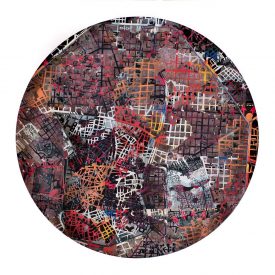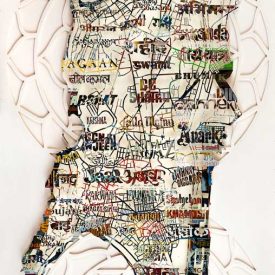The sculpture of Madrid contains elements pertaining to several distinct periods in the history of the city. The sculpture has been cut away in layers to reveal earlier periods, with the center and lowest part of the sculpture being defined by a map that depicts the old city from the 16th century. This period of Madrid’s history under the rule of Philip the II was known as “The Golden age”, a time in which there was a remarkable cultural flowering in art music and literature. The Spain of this time, with it’s extensive empire was the most powerful country in Europe. The old city is framed by the noblemen that appear in the painting by El Greco, “The Burial of The Count of Orgaz”, a painting which appears to not only project the magnificence and power of the monarchy and the Catholic church but also to present the central role of the religious order in the society of that time.
Madrid has a history that is somewhat cyclical in nature, occupied by the Portuguese in 1706 and one hundred years later by Napoleon in 1808. As part of the Carlist wars It experienced a civil war in 1836 and again a hundred years later found itself to be the first major city to experience modern warfare as part of another civil war. Goya’s drawings “The Disasters of War’ created in response to the brutalities of the Peninsular wars of 1807 seem to reach across the centuries and provide a fitting testimony to the sufferings of the populace in both the nineteenth and twentieth centuries. Fragments of these drawings line the circumference of the middle section of the sculpture. Underlying the central section of the sculpture is a fragmented map from 1857. Below this map are posters from the 1959 film Death on a Bicycle, images of which can be glimpsed through the cut and disrupted forms of the map. Glimpses of the poster for the 1976 film by Carlos Saura, Cria Curves can also be found elsewhere in the sculpture. Cria Cuervos was made just after the end of the Franco era and can be seen as a reflection upon the repressions of Spanish society during that era.
The cut away street form of Madrid has been taken from a contemporary map of the city as it is today. This map has been cut from propaganda posters from the civil war, these posters have been taken from both sides in equal measure. The resultant fragmented imagery is suggestive of the powerful forces that played themselves out across the cityscape in the late 1930s. The content provides an allusion and testimony to this traumatic and divisive period in the city’s history.

















